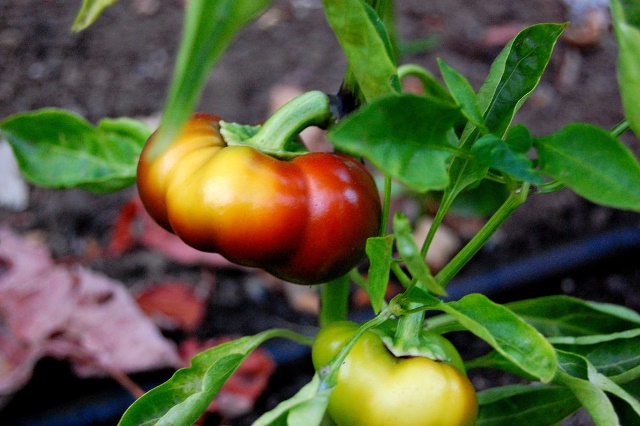Have you ever enjoyed a stripey heirloom tomato that was perfectly ripened while still bright green? Or bit into a juicy purple tomato that tasted naturally salted? How about decorating your salad with tiny black cherry tomatoes?
If you walk into your local supermarket you will find several varieties of tomatoes for sale: Romas, “on-the-vine”, one or two types of cherry tomatoes, and maybe a big Beefeater style slicing tomato for sandwiches. Many people go through life eating, and often disliking, the same four or five types of tomatoes, when there are literally hundreds of colorful and delicious heirloom tomatoes just waiting to be tasted.
Whether you are simply looking for the best varieties of heirloom tomatoes or for detailed instructions on how to grow them, you’ve come to the right page. This guide will cover everything you need to know about heirloom tomatoes.
What is an Heirloom Tomato?
There is not a single definition of “heirloom tomato”. Nearly every gardener and farmer has a slightly different opinion. Heritage chickens, goats, ducks and other livestock are clearly defined by the Livestock Conservancy, but no such authoritative organization exists for defining heirloom produce.
Some people say that an heirloom tomato variety must be over 100 years old, others say 50 years. Still more claim that they must have existed prior to 1945, when hybrid tomato seeds became widespread as industrial agriculture was born in the wake of World War II. Others claim that a true heirloom tomato has been carefully cultivated and passed down from person to person within a family for many generations.
While an exact, universal definition is impossible, there are a couple important characteristics that everyone agrees on when it comes to heirloom tomatoes.
An heirloom tomato must be:
- Open Pollinated – This means that when the plant self-pollinates or crosses with another plant of the same variety the resultant seed will produce a plant very similar to the parents. Hybrid tomatoes don’t “breed true” like heirloom tomatoes. Seeds from hybrid tomatoes will not grow a new crop of the same tomatoes, making the gardener reliant on the seed company for new seeds each year. If you care for your heirloom tomatoes properly you will never have to buy new seeds, you can simply save your own.
- Non GMO – It is generally agreed that no genetically modified organisms can be classified as heirloom tomatoes.
Types of Heirloom Tomatoes
There are hundreds, if not thousands, of types of heirloom tomatoes. It is impossible to say exactly how many are out there, as lots of them are not available to purchase but rather are passed from parent to child in family gardens all over the world. One of the most complete lists of heirloom tomatoes can be found at Tatiana’s Tomato Base.
When you are reading about heirloom tomatoes, you will often see them described as “classic” or “old-fashioned” in flavor. This means that the balance of sugar to acid in the tomato is as close to 50/50 as possible.
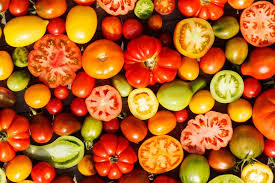
Image courtesy of atlanticavenuegarden.com
Commercial Heirloom Varieties
Some heirloom tomatoes really have been handed down from generation to generation within a family. These tend to be rare seeds that are available to the public in limited amounts, if at all. Some varieties are carefully propagated by a seed company. The most popular of these seeds have been spread to various seed companies and continue to be available even if the original company goes out of business. These are the common heirloom tomatoes you see in many different seed catalogs. They are the types you have probably already tasted at the farmer’s market or perhaps even at your grocery store.
Here are 9 of the most common heirloom tomatoes:
- Brandywine – These large (up to 2 lbs) red tomatoes are perhaps the most popular of the heirloom varieties. They date back to the 1800’s, are indeterminate and have an intense, classic tomato flavor. Perfect for fat tomato sandwiches.
- Green Zebra – A more modern variety, the Green Zebra is fun to grow. The fruit is gold with bright green stripes. They are a bit acidic but with a rich tomato flavor. Many people consider them the best tasting heirloom tomatoes. This indeterminate variety is good for saving seeds.
- Cherokee Purple – This dense heirloom tomato is a deep purple or even black color, inside and out. They are famous for having a naturally salty flavor. These large tomatoes are perfect for eating plain slices.
- Beefsteak – A large slicing heirloom tomato with a deep red color the beefsteak is the most well-known of the heirloom tomatoes. It has a wrinkled, ridged shape and powerful tomato taste. This indeterminate tomato will produce lots of fruit over a long growing season.
- Great White – White heirloom tomatoes are actually a pale yellow, with a mild flavor. This is a sweet tomato with low acidity.
- Orange King – This brightly colored orange heirloom tomato does well in cooler weather than most tomatoes. It is the perfect heirloom variety for northern gardeners with a short growing season. They are indeterminate with a rich tomato taste.
- Gold Rush Currant – This tiny plant produces abundant bright yellow cherry tomatoes and will fit into the tightest garden plan.
- Black Zebra – These are firm cherry tomatoes, a deep, dark red color with green stripes. They are easily sliced and great on salads.
- Sun Gold – Another golden colored cherry heirloom tomato, Sun Gold is the perfect snacking tomato. It has a rich flavor even before it is fully ripe.
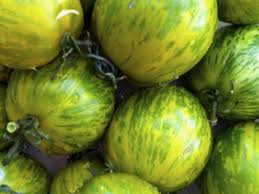
Image courtesy of christinecassidy.blogspot.com
Paste Heirlooms
Paste tomatoes have dense flesh and less water than other types of heirloom tomatoes. They are ideal for making sauces because they don’t have to be cooked very long to become thick and concentrate their flavor. Shorter cooking times help to preserve vitamins and nutrients. In the garden paste tomatoes are usually determinate varieties, so the fruit ripens all at once. This way you can do all your sauce making and canning tomatoes at one time.
The classic paste tomato these days is the Roma, though the San Marzano is enjoying increasing popularity, but there are many delicious heirloom paste tomatoes too.
Here are a 7 flavorful options:
- Opalka – A flavorful Polish heirloom tomato, the Opalka is a vigorous grower and produces a high yield of quality paste tomatoes.
- Amish Paste – Some people love the Amish Paste tomato, while others find it a bit watery for sauce making. The flavor is incredible, and the water content seems to depend on soil conditions and climate.
- Cuore Di Bue – The name is Italian for Oxheart. With a heavy bottom, thick flesh and incredible flavor, this makes a great paste tomato.
- Andes – This French heirloom tomato can grow up to seven inches long and three inches wide. It is shaped like a pepper, with dense flesh and few seeds for easy straining.
- Big Italian Plum – Another pepper shaped heirloom tomato, the Big Italian Plums can reach 12 ounces easily. They make a thick paste and delicious sauces.
- Cream Sausage – Looking for an unusual sauce that will gather the “oohs” and “aahs” at your next dinner party? Try the pale yellow Cream Sausage heirloom tomatoes. They have a sweet flavor and make a beautiful pale pasta sauce or salsa.
- Goldman’s Italian American – This large heirloom tomato was discovered by a Brooklyn woman visiting a roadside stand in Italy. They easily reach a pound in size and have an incredible silky texture that makes a divine sauce.
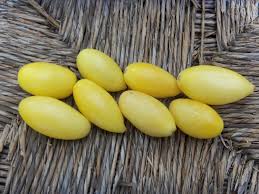
Image courtesy of snakeriverseeds.com
Tasty and Colorful Heirlooms
Half the fun of growing heirloom tomatoes is enjoying their amazing flavor. The rest comes from the wild variety of shapes and colors that they bring to your garden and your table.
Here are 6 incredibly delicious and delightfully funky heirloom tomato varieties:
- Aunt Ruby’s German Green – This bright green tomato has a pleasing dark green crown and a perfect balance of sugar and acidity. They take fried green tomatoes to a whole new level.
- Cassidy’s Folly – You’ve never seen (or tasted) an heirloom tomato like this before. It is an elongated plum tomato with psychedelic coloring, ranging from red to orange with brilliant stripes. It is a great paste variety with rich flavor.
- Rose de Berne – This glowing bright pink salad tomato offers huge yields of juicy, firm fruit.
- Blueberries – These tiny cherry tomatoes are more than fun and colorful. They are rich in anthocyanins, a powerful anti-oxidant.
- Dixie Golden Giant – These large slicing tomatoes have a bright golden color that adds beauty to any salad or sandwich. The flavor is sweet and strong and the plants are high yielding.
- Limmony – Sometimes spelled Lemony, this bright yellow beefsteak tomato has a crisp, citrus flavor that is unique even among the many heirloom tomatoes available.
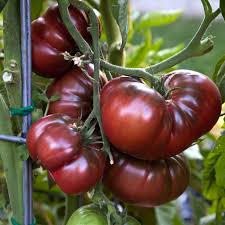
Image courtesy of omaha-mens-garden-club.com
If Heirlooms are so Great, Why do Hybrid Varieties Exist?
So why aren’t you seeing pepper shaped, pale yellow Cream Sausage tomatoes and other heirloom varieties at the supermarket every day? If the taste is so much better, why bother with hybrid tomatoes at all? While there are many great heirlooms out there that thrive in a variety of climates, they are generally not well-suited for large-scale agriculture. Hybrid tomatoes tend to produce much higher yields. Their uniform shape allows for machine planting, weeding and harvesting. They last longer after picking and can be shipped around the world. And many have been bred to be resistant to various blights and tomato pests. It is easier and more profitable to farm hybrid tomatoes than heirloom tomatoes on a large scale.
Growing Tomatoes
Heirloom tomatoes are actually tropical perennials, but they are typically grown as annuals in temperate climates. Heirloom tomatoes love sun, heat and water, though most types stop producing if temperatures are above 95° F. Fortunately there are many tomatoes that have been bred to tolerate cooler weather, so it is possible for nearly any home gardener to grow at least a few early season varieties.
If you have a green house or warm, sunny space indoors you can try keeping a few plants in containers year round. There are many people with five year old heirloom tomatoes still producing indoors. Choose a dwarf or cherry heirloom tomato variety for best results.
Growing heirloom tomatoes is much like growing regular tomatoes. We’ll start with the basics of tomato growing, then consider a few specific tips for success with heirloom varieties.
Planting Tomatoes
Move your heirloom tomatoes around your garden. To prevent disease, wait three years before planting tomatoes in the same garden bed. All tomatoes are members of the nightshade plant family, which also includes peppers, eggplant and potatoes. The plants in this family can share diseases, so avoid planting tomatoes where any other nightshade was planted in the last 2-3 years.
Spacing
The amount of space an individual tomato plant needs varies greatly based on a few factors:
- Determinate or Indeterminate – Determinate heirloom tomatoes produce all their fruit at once and stop growing after they start forming tomatoes. These tend to be shorter, bushier plants. Most heirloom tomatoes are indeterminate, which means they just keep growing and producing throughout the season. These plants can become huge and will need the support of trellises or cages. Fortunately they are easily trained, and you can encourage upward growth to save space in the garden.
- Type of Tomato – In general, cherry tomatoes are smaller plants than large beefsteak varieties. You can purchase dwarf tomato seeds, which grow into tiny plants that do well in containers. The information on your seed packet will help you determine the future size of your tomato plants.
- Pruning – Heirloom tomatoes grow “suckers”. These branches grow in the fork of a “true branch” and tend to grow upwards. While they can produce fruit, many people prefer to prune the suckers, allowing the tomato to focus its energy on the existing branches and grow more fruit. It also helps control the size of the plant. Be cautious however, as many heirloom tomatoes actually give higher yields without pruning.
Starting Seeds Indoors or Out?
If you live in a warm climate with a long growing season, like most of the Southern states, you can plant heirloom tomatoes directly in your garden. Place seeds 1/2 inch deep, and plant generously. You can thin the seedlings later, choosing the most vigorous plants.
Depending on the type, tomatoes need temperatures between 55°F-75°F to germinate successfully. If you live in a cooler climate or have a short growing season, you can try one of these tricks to give your heirloom tomatoes a few extra weeks or months to mature:
- Start Seeds Outdoors Under Cover – Plant seeds in the garden 1/4 inch deep. Cover the soil with a large jar, plastic jug or plastic sheeting. Leave a small space open on one side to allow ventilation. Keep the soil evenly moist. You’re hoping for temperatures around 70°F under the jug. After the seed sprouts remove the cover. You can transplant immediately to their permenant location, or wait till they grow their second set of true leaves.
- Start Seeds Indoors – It is easy to start tomato seedlings inside. You can place the seed tray in a sunny window, or start them under a fluorescent bulb. Seedlings transplant easily. Consider starting lots of seeds in a flat, then pinching out the seedlings and moving them into small pots. They can stay in the pots until it is warm enough to move them outdoors. If this takes awhile, you may need to transplant into larger pots to encourage healthy growth.
- Use a Cold Frame – A cold frame is a little more permanent than a simple plastic jug. You can build a glass or plastic cover that fits a single plant or an entire section of the garden. A cold frame can be used for the first few weeks to months. Ideally you should be able to prop it open on warm days to allow air to circulate and to gradually expose the young plants to the weather.
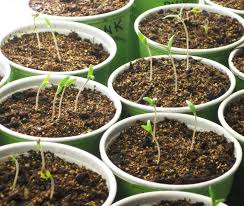
Image courtesy of homesteadingdownsized.com
If you transplant tomatoes into the garden, space them carefully. Some large heirloom tomatoes do well spaced up to four feet apart. You can always crowd plants a bit if necessary, but keep in mind that your yields will suffer if each tomato doesn’t have ample room for roots and foliage.
How Many Tomato Plants?
The answer to this question depends a lot on the variety. Even six average heirloom tomato plants will provide a decent number for summer eating, while 20 will give you lots of tomatoes for canning and sharing with friends. With a hundred plants you can easily sell at local markets all summer long.
For your first season, try growing a few plants of several different varieties. It may take a few tries to find the perfect heirloom tomato for your climate, soil and appetite. After a season or two you will be able to estimate your family’s needs more easily.
Feeding Heirloom Tomatoes
Heirloom tomatoes like compost and rich soil. While you can purchase fertilizers, the best options are natural ones. Work horse, cow, goat or chicken manure into the soil before planting, and add a generous layer of mature compost on top. With these amendments your tomatoes will thrive all summer long. If you do choose to use a spray on fertilizer or add tomato food to the water, do so cautiously. It is very easy to over fertilize, damaging your plants. Always start with the minimum recommended amount.
Here are a few natural ways to keep your heirloom tomato plants well fed:
- Companion Planting – Try growing nutrient building plants like clover, borage or chamomile around your tomatoes. These plants pull up minerals and nutrients from deep in the soil and deposit them in the first few inches, where tomato roots can absorb them.
- Plant a Green Manure – Maybe tomatoes won’t grow in the chilly spring months, but many cover crops will. Try planting alfalfa, peas, radishes, rye or buckwheat before your tomatoes go in the ground. These plants can be tilled into the soil or cut and allowed to rot on top. In most climates you can get a full cycle of buckwheat or radishes in before it warms up enough for tomatoes. Let radishes rot in the soil to add organic material.
- Use a Compost Tea – The best way to apply compost to your garden is to till it in or place it on top of the soil. However, if your plants need a boost in the middle of the season, you can brew a compost tea as a tomato “pick-me-up”. Fill a 5 gallon bucket 1/3 full with mature compost, and cover with water. Let sit for one week, stirring three times a day. Strain the water and spray directly on plant leaves. Do not use more than once per month.
Watering Tomato Plants
Immediately after planting, tomato seeds need to stay moist. Keep the surface slightly wet for the first week until germination. After this continue to water frequently and lightly, being careful not wet the leaves of the seedling.
Once the plant has 3 sets of true leaves and is well-situated in its final location in the garden, you can water more sparingly. However, tomatoes need consistent watering. If they suffer wet and dry spells the fruit can crack or even fail to set at all. It is best to water lightly every 2-3 days. If you water all at once it will cause heirloom tomatoes, which tend to be thin skinned, to crack and split. Check the soil and don’t let it dry out to a depth of more than 2-3 inches. Mulch around the base of the tomatoes can help conserve water.
Heirloom tomatoes hate having wet leaves. It encourages mold, mildew and blight. As much as possible water only the base of your tomato plants.
Support for Tomato Plants
Most heirloom tomatoes are sprawling indeterminate types. They are healthiest if you keep their leaves off the ground, and encouraging upward growth conserves garden space. They will need support as they grow, especially the large beefsteak and brandywine types. Large tomatoes can break the vines if they get heavy enough.
Trellises and Cages
There are many ways to provide support to your heirloom tomato plants as they grow:
- Fence – If you have a fence around your garden, place the tomato plants near it. You can tie the stems to the fence as the plant grows.
- Trellis – You can purchase a trellis or build your own. It can be made of wood, wire or even heavy string or rope.
- Cages – Most commercial tomato cages are not strong enough for large heirloom varieties. You can build your own using heavy wire.
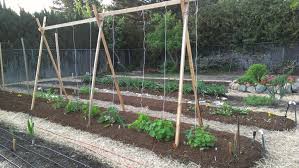
Image courtesy of theurbanfarm.com
Calcium/Phosphate Spray
This easy homemade spray should be applied to tomatoes just as they begin to flower. The calcium strengthens the stems to help support heavy fruit, while the phosphorus helps the roots absorb more water and nutrients from the soil. The spray needs to sit for 3 weeks, so be sure to start it early.
Flowering Tomato Spray Recipe
- Gather enough egg shells to make 1 cup when crushed.
- Thoroughly rinse egg shells.
- Cook shells in a dry skillet until some shells are black (calcium) and some are white (phosphorus).
- Place in a jar with 5 cups of vinegar.
- Watch it bubble.
- When bubbling stops, seal the jar.
- Let sit for 20 days.
- Strain.
- When you are ready to use the spray, mix one tablespoon of the vinegar/egg shell mixture with one gallon of water.
Tips for Growing Heirlooms
Heirloom tomatoes are different than the typical commercial hybrid. They tend to grow bigger, lankier and may not have as much resistance to disease. Here are some tips to help you grow big, beautiful heirloom tomatoes the first time you try:
- Give them Extra Space – It is tempting to crowd tomato plants together, especially when transplanting small seedlings. Resist! Give each plant plenty of room to grow, both above and below ground. This will reduce the risk of disease, increase yields and make training the plants to a trellis or support easier.
- Use Mulch – A thick layer of mulch under your plants offers several benefits. It conserves water, prevents the soil from splashing away, warms the soil and adds nutrients over time as it decomposes.
- Cull Diseased Plants – Check your plants frequently for any signs of disease. The moment a plant shows evidence of infection, pull it from the garden. Do not place diseased heirloom tomato plants in your compost pile.
- Start them Inside – Heirloom tomatoes tend to be more delicate than hybrids. Starting them indoors and transplanting vigorous seedlings into the garden will increase your chances of success.
- Use Strong Trellises – Heirloom tomatoes can get huge. Some growers report plants well over 6 feet in height. Plan your stakes or trellises accordingly. Make sure they are strong and large enough.
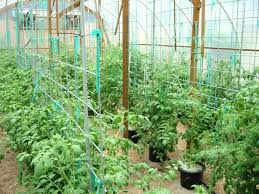
Image courtesy of geradandlauracoles.com
Buying Heirloom Tomato Plants
Starting heirloom tomatoes from seed can be a daunting task. You have to start them at the right time so they are big and strong enough to go outdoors when the weather turns nice, but not too early or they may get too big for their containers. Many gardeners prefer to start out with healthy heirloom tomato plants.
Things to Look for When Choosing Heirloom Tomato Plants:
- Pot vs. Plant Size – The heirloom tomato plant should be in proportion to the size of the container it is in. If the roots of the plant have grown too much for the pot they will hit the edges and start to turn inwards. Eventually you can end up with a root bound plant that has all of its roots growing in a circle. A large plant in a small pot could be rootbound and won’t do well after transplanting.
- Stem Thickness – Look for an heirloom tomato plant with a thick stem. A tall plant with a thin stem was stressed as a seedling, reaching for light. It will do poorly in windy or wet conditions later on.
- White Nodes on Stem – Little white bumps on the bottom of the stem are new roots trying to grow. Plant the heirloom tomato deep enough to cover all of those white nodes and the plant will grow extra roots and more tomatoes.
- Proper Hardening Off – If you are buying an heirloom tomato plant at an outdoor market you need to check to make sure it was properly hardened off. If it is drooping or wilting outdoors don’t buy it. If you are purchasing from a catalog ask to be sure. Even a beautifully healthy heirloom tomato plant that is not hardened off correctly will wilt and droop when transplanted.
- Look for Parasites – Check the undersides of the leaves for aphids or other small bugs.
- Choose Green Leaves – Their may be a couple bottom leaves that are pale in color due to windburn or sunburn. If a plant is yellow it might be lacking nitrogen, while a maroon or red leaf indicates iron deficiency. While good soil and feeding will help, if a plant has suffered nutrient deficiencies for too long it may be stunted.
Things to Avoid when Choosing Tomato Plants:
There are a few “don’ts” when it comes to choosing an heirloom tomato plant:
- Don’t Get Plants with Tomatoes Already on Them – While it is fun to see a plant already fruiting at the market, these heirloom tomatoes have put too much early energy into fruiting. They will give low yields throughout the summer.
- Don’t Get Plants with Blossoms – Early blossoms are a sign that the plant has been stressed and is rushing to produce. It will also produce poor yields.
Where to Buy Tomato Plants
There are several places you can order heirloom tomato plants on the internet. However, it is best to purchase them from a local gardener or farmer’s market’s. The grower will be able to answer questions about how the plant was grown, plus they will likely offer a variety that does well in your area.
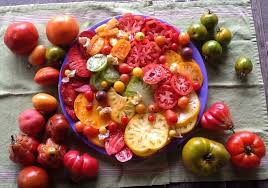
Image courtesy of post-gazette.com
Growing Tomatoes in Containers
Just because you have a small space doesn’t mean you can’t enjoy the delicious flavors of homegrown heirloom tomatoes. Many varieties of heirloom tomatoes do well in containers and can be grown on a balcony, porch or even indoors. Containers are also a great option for growers in northern regions because they are easily moved indoors if an early frost threatens.
Size of Container for Growing Tomatoes
The rule of thumb for choosing a container for heirloom tomatoes is: the bigger the better! Heirloom tomatoes have large roots systems. The more room they have to spread their roots out the more juicy tomatoes they’ll produce. A large container also prevents the soil from drying out during hot summer days.
Minimum Pot Size – Don’t go smaller than a 5 gallon container. Larger varieties of indeterminate heirloom tomatoes need 12-18 gallon containers. Any pot should have holes punched in the bottom for drainage. If you plan to move the container around to maximize exposure to the sun or to bring the plant inside at night consider placing a platform with wheels under the pot.
Potting Medium – Don’t use garden soil in containers because it doesn’t drain well. Use a high quality potting soil with lots of organic material. Good compost adds organic material and nutrients. Mix it in freely and add mulch on top to prevent moisture loss.
Feeding Potted Tomatoes – If your soil mixture has lots of compost your heirloom tomatoes will have most of the nutrients they need. You can supplement with a monthly spray of compost tea. Other good organic options include fish emulsion and liquid seaweed which can be used once a week.
Watering Potted Tomatoes – It is essential to water your heirloom tomatoes regularly. Containers dry out more quickly than a garden bed and dry soil can cause blossom rot. Never allow your containers to dry completely. In fact, the soil should never be dry more than an inch from the surface. Don’t be afraid of over-watering as long as you are using a soil mixture that has lots of organic material. It will drain freely. Just don’t over-water during fruit-set as this can cause the heirloom tomatoes to split.
Best Heirlooms for Container Growing
Here are a few of the best heirloom tomato varieties for growing in containers:
- Principe Borghese – A large determinate heirloom tomato plant, the Principe produces abundant small egg-shaped tomatoes with powerful flavor.
- Manitoba – Another determinate heirloom tomato the Manitoba is a vigorous grower and an early finisher. Enjoy lots of large, rich slicing tomatoes.
- New Yorker – You’ll love the meaty fruits from this bush shaped determinate heirloom tomato plant. They thrive in cool weather.
- Japanese Black Trifele – This heirloom tomato is so beautiful it makes an ornamental addition to the patio. It is compact for an indeterminate variety and can be supported with a single stake. Despite the name, the fruit is a stunning bronze color.
Saving Seeds
Heirloom tomatoes have self-fertile wind and insect pollinated flowers. This means that you only need a single plant to get viable seeds. Remember, any heirloom tomato will be open pollinated, so its seeds should produce a plant very similar to the parent.
What about cross pollination?
Because tomatoes are self-fertile, the risk of cross pollination is low. If you are growing more than one variety separate them into different garden beds, or place a screen of peas, beans, corn or sunflowers between the rows of tomatoes to form a physical barrier. If you are attempting to preserve a rare strain you should isolate it more carefully, but these simple precautions are suitable for typical seed saving.
How do you harvest tomato seeds?
Tomato seeds can be saved casually by simply air drying them. Just cut open the tomato (choose the best fruits from each plant for seed saving) and lay the seeds on a plate or paper towel. When they are completely dry place them in a container where they are protected from humidity.
While this method is effective, fermenting the seeds is better.
Benefits of Fermenting Heirloom Tomato Seeds:
- Removes Germination Inhibitors
- Removes Gelatinous Sheath – Which can also slow germination.
- Destroys Many Seed Borne Diseases
- Lengthens Storage Life – Seeds can be viable for up to six years.
Fortunately it is easy to ferment your seeds for saving. Just follow these easy steps:
- Scoop the seeds into a jar and cover with a few tablespoons of water.
- Cover the jar with plastic wrap and leave in a warm place out of direct sunlight for 3-5 days.
- A layer of mold will develop. It may thin or thick, white or green, mild or stinky. It is normal.
- After 5 days, remove as much mold as possible with a spoon or eye dropper.
- Gently rinse the seeds under running water. They will tend to stick to the bottom of the jar.
- When seeds are thoroughly rinsed, spread them on a paper towel to dry.
- Store completely dried seeds in an airtight container out of direct sunlight.
Buy Heirloom Seeds
You can find heirloom tomato seeds from a number of quality seed companies. If you are looking for a rare variety, ask around at your local farmer’s market. You may be able to purchase seeds directly from a local grower who is committed to preserving their favorite heirloom tomatoes.
Here’s a list of seed companies that offer high quality heirloom tomato seeds.
- Baker Creek Heirloom Seeds – They offer a colorful catalog with great images and compelling descriptions. While the seeds from Baker Creek tend to be a bit pricey, they do carry many rare heirloom tomato varieties like Vorlon or Goldmans that can’t be found anywhere else.
- Pinetree Garden Seeds – The go to choice for a small gardener, Pinetree Garden sells packs of 10-20 seeds (most of the others send 30-40) at a lower price. They have great germination rates on all their seeds.
- Tomato Fest – Order organic heirloom tomato seeds from Tomato Fest. They have over 600 varieties of heirloom tomatoes, including some exclusive varieties that simply can’t be bought elsewhere.
- Seeds of Change – Another 100% organic seed company, Seeds of Change offers quality seeds, good germination rates and excellent customer service, though the selection is limited.
- Totally Tomatoes – This company offers a wide variety of both heirloom and hybrid tomato seeds. You can also buy sweet and hot peppers at Totally Tomatoes, all for reasonable prices.
Learn more about growing heirloom tomatoes: blossom end rot, watering, how to build a hot house and more!

